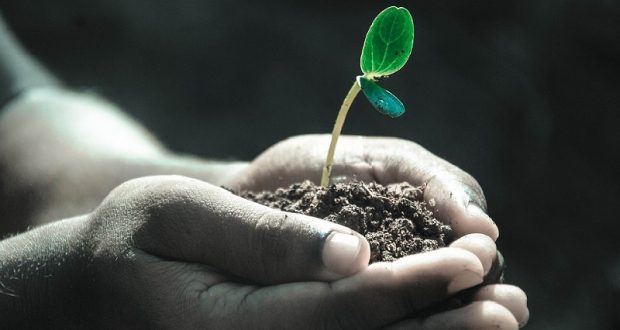By Brian David —
This new year welcomes us into its vibrancy. Air, water; sand, clay and silt pulse with wiggling earthworms, dancing bacteria and exercising fungi. From the soil’s fertile womb our earth births seeds into plants and covers her modest bare ground with carpets green and brown.
Three fourths of all plant roots interact in mutually beneficial relationships with soil fungi. One-quarter teaspoon of precious soil can house up to four billion bacteria, one million fungi, and three hundred thousand algae. Earthworms aerate around the root zone and convert organic materials to humus releasing nutrients to micro-organisms and plant roots.
Like space is an essential component in music and art creating meaningful expressions of sight and sound, soil components require space between their parts to create lush vegetation. Space shares a fifty-fifty ratio with soil. The space between soil particles fills with air or water.
Gardeners and growers may broadcast cover crop seeds like alfalfa, clover, vetch, bell beans and peas — all good cool weather cover crops that increase soil fertility.
Covering bare soil with organic mulch helps preserve and protect soil health. For soils not overlaid with cover crops, try mixing in vermiculite or perlite to improve soil arability and water-holding capacity. Good compost, comprised of equal parts of decayed green and brown vegetation, will boost soil vitality. Power shots of blood meal and bone meal can be added to your compost for a fortified mix.
Healthy soil promotes wholesome plants that can ward off pests and disease. If you add fertilizer to your soil, mix it in several weeks to a month or more before seeding so it will have time to integrate into the underground community of living organisms.
Soil minerals fall into three categories: sand, silt and clay; the list goes from the largest particles to the smallest. The predominate particle type determines the soil’s character and name. Loam is a balanced combination of sand, clay, silt and decayed organic matter known as humus. To get a feel for your soil type, moisten a soil sample and rub it between your forefinger and thumb. Sandy soil will feel gritty. Silty soil feels silky and slippery. Clay soil feels sticky and can be formed into shapes.
Sandy soils heat up fast and drain water quickly. Silty soils warm up more slowly but hold more water than sandy soils. Clay soils have a high water-holding capacity and the smallest area for air. Each soil type has pros and cons for gardening. A good garden soil will be a loam mixture of all three soil types with plenty of humus.
May your new year be full of days running your hands through vibrant soils eager to embrace new seeds and seedlings. Happy new earth!
Brian David is a U.C. Master Gardener, Mariposa
Visit our UCMG website
Follow us on Facebook
Listen to local interviews on KRYZ 98.5 FM
The U.C. Master Gardener Helpline and Helpdesk are staffed Thursdays from 2 – 5 p.m. Please contact the helpline, or leave a message by phone at: (209) 966-7078. By email (send photos and questions for researched answers) to: mgmariposa@ucdavis.edu
Master Gardener Office Location:
UC Cooperative Extension Office, 5009 Fairgrounds Road, Mariposa, CA 95338
Phone: (209) 966-2417
Email: mgmariposa@ucdavis.edu
Website: http://cemariposa.ucanr.edu/Master Gardener/




